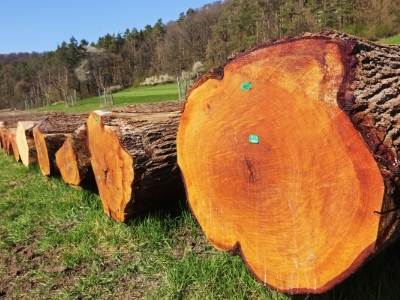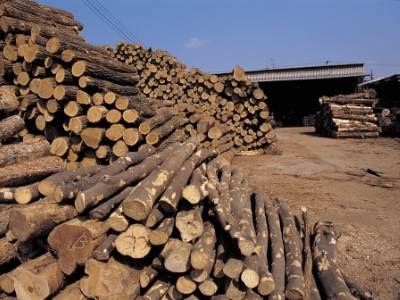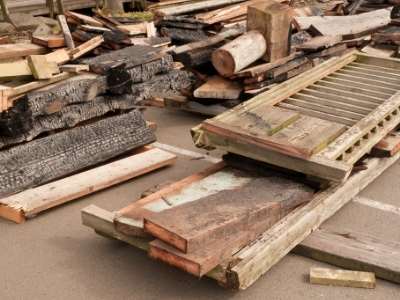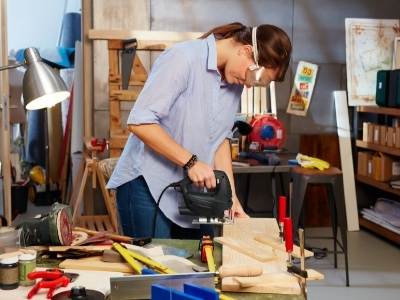Woodworking is an art that has been around for centuries. It’s one of the oldest crafts on earth and can be traced back to prehistoric times. Woodworkers have used many different types of wood over the years, but there are only a few varieties that are widely popular in North America today: hardwood and softwood.
Hardwoods are typically more expensive than softwoods because they’re denser and heavier than their counterparts, making them better suited for heavy-duty projects like building furniture or cabinets.
Whether you’re looking to buy some new hardwood for your next project or just curious as to what all this “hardwood” business is about, this article will help answer any questions you may have!
What Is Hardwood?
Hardwood is defined as “wood from deciduous trees, such as oak, walnut, and maple that is neither soft nor brittle.” It’s also denser than its counterpart (softwood) because the trees are slow-growing and store more nutrients.
Typically hardwood is harvested from angiosperm or flowering trees. They are generally grown in tropical forests, and broad-leaved temperate areas such as New Zealand, South America, eastern Australia, southern China, Korea, and Japan are rich in hardwoods.
Some hardwoods, such as oak, have growth rings. They are, however, absent in tropical species. Alder, Blackbutt, Oak, Beech, Hickory, Mahogany, Maple, Teak, Balsa, Spotted Gum, and walnuts are some of the most commonly used hardwood trees.
It’s noteworthy that all hardwood isn’t hard enough. Some hardwood species, such as yew and balsa, are softer than softwood as well.

What Are The Benefits Of Using Hardwood In Woodworking Projects?
Woodworking is a great way to get your creative juices flowing and express yourself through the process of creating something from nothing.
Whether you are making furniture or art, there are many benefits that come along with using hardwood in woodworking projects.
Strength:
Hardwoods can be expensive, but they will last much longer than cheaper softwoods, which means it’s worth investing more money up front for the long-term durability and beauty of hardwoods.
Easy Maintenance:
Another significant benefit of hardwood is its ease of cleaning and maintenance. It is also easy to fix scratches or dents. Hardwoods are a common choice for flooring because of this. Regular mops or sweepers and cleaning agents may be used to clean hardwood floors.
Hardwood floors are not only easy to dust, but they are also attractive and comfortable. It will keep you warm throughout the winter because it is a strong insulator (it has thousands of micro-air chambers per cubic inch).
Appearance:
You will find a wide range of species of hardwood around the globe. And each has its own design and color, making them desirable materials for furniture and other decorative home products.
Fire Resistance:
Hardwoods are less susceptible to fire than softwoods due to their high density. As a result, it has become one of the most trusted home improvement products among wood contractors.
Hardwoods, on the other hand, are slow-growing trees and need more money to access than softwoods. It’s also a little challenging to control them to get the shape you want. Regardless of these issues, every woodworker’s first preference is hardwood.
How To Choose Quality Hardwood For Your Project
Choosing a quality piece of hardwood can be difficult, but the following guide should help. First, you want to look for wood that has been dried properly. This is true for all woods, not just hardwoods! The drying process removes excess moisture and prevents mold from forming. Properly dried wood also gives stability to your furniture or art and ensures that it will not expand or contract from seasonal fluctuations.
Choosing the wood with a grain pattern you like is important too, as this will have an effect on how your projects develop over time. Most hardwoods are made up of three different grains: sapwood, heartwood, and quarter-sawed (or rift) cut boards.
Sapwood is found at the outside edge of a tree trunk where there’s more moisture in the wood than inside, resulting in lighter coloration of sap to almost white, while heartwood has darker colors but still lightens somewhat due to being exposed to air for longer periods before finish stage which results in yellow shades.
Quarter-sawn boards should be chosen if you want maximum stability because they offer the uniformity and hardness required for tough construction projects.
Both sapwood and heartwood can be used for decorative purposes, such as a tabletop or headboard but should not be used for objects that require strenuous weight-bearing.

Most hardwoods come in a variety of grades, with AAAA being the highest quality and AA being the lowest. It’s important to know what you want from your wood before you buy it because it will help you decide the type of wood that is best for you.
Softwoods like cedar, pine, and red oak are great if you want something lighter, while harder woods like walnut provide more stability but are more expensive because they’re made up mostly of dark veneer layers on a softer core mat.
Wood often has flaws built into it that make it less expensive. These flaws are known as “knots,” and they appear when a branch on a tree grows out of place or when some natural occurrence occurs. Woodworkers should avoid knotted hardwoods.
The grain orientation of the wood should also be considered by woodworkers since it determines how solid and stable the wood is.
The Tools You Will Need Before Starting Any Project Involving Hardwood
I always start with the right tools and supplies before starting a project. There are many different materials that I work with, but for this article, I’m going to talk about hardwoods.
There are some basic tools that you’ll need when working with hardwood:
all come in handy at various stages of your project.
Some tools are must-haves for any kind of project like
- a hammer or a nail gun,
- mallet,
- tape measure,
- square,
- circular saw,
- files,
- sanders,
- planes, etc.
And then, there is also a variety of other hand-tool options available as well to help you achieve the desired end product. For example, chisels can be used to shape wood by carving away at it, or gouges can be used for deeper cuts into the material, so they’re not as visible after sanding down any rough spots on your finished project.
To start your project from scratch, you will also need a sawhorse and a quality workbench with clamps and vise. Though you can develop your own workbench with 2x4s and plywood, a professional-grade workbench will give you enough leverage for working with solid hardwoods.
If you want to know more about beginner woodworking tools, you may browse this blog post.
Where To Buy Hardwood For Woodworking
Where do you buy hardwood for woodworking? This is a question that many people are asking due to the rising cost of lumber. With so many places to purchase materials, it can be overwhelming trying to figure out where you should go and what you need in order to make your shopping trip successful.
Let’s look at a few common locations from where you can collect your hardwood stock conveniently and at a reasonable price.
Woodworking Retail Stores:
If you are looking for the best quality hardwoods, then your local woodworking retail store is a good place to start. You will find everything from live edge slabs and reclaimed lumber to pre-cut boards in their inventory.
Another fun aspect of retail stores is that they are constantly attempting to collect something new that is not available in large stores. You could find some lovely wood corbels or appliques there, for example.
Hardware Stores:
Hardware stores also carry some types of woods like oak or pine that are perfect if you need something sturdy but don’t want to spend too much money on exotic species. Be aware that what they have available might vary depending on where it’s located, so call ahead before making an unplanned visit!

Hardwood Stores:
These stores usually carry hardwoods that people often use for more detailed projects like furniture, flooring, cabinetry, or any other project where they want something nicer than softwood.
Hardwood stores are usually smaller category stores with a lot of different shapes and qualities of hardwood. Here you can find wood from all over the world.
As a result, it might be challenging to find what you’re looking for due to the wide variety of materials available, each with its own set of characteristics and benefits!
In general, these establishments have higher prices but better service, so if it’s not too far out of your way, then take some time to visit one today!
Lumber Yards:
A lumberyard is a good place to go if you need a large quantity of hardwood for a construction project. In the lumber yard, you’ll find a wide range of wood to choose from, making it simple to find what you’re looking for. Some species (such as rosewood) are only found here and may not be found anywhere else.
There is a misconception that the cost of wood in lumber yards is higher than in big box stores. However, the reality is very different. They would be more competitive than other outlets because they specialize in this field. The type of wood also matters.
However, if you want to compare prices before moving here, you should look locally first. Purchasing from here isn’t always a good idea unless your project is big enough that shipping costs cover the bulk of the price difference!

Ordering Wood Online:
Ordering high-quality hardwood as desired from around the world is no longer a concern, thanks to the internet’s blessing. While you’re sitting in your shop at Clevland, you can order wood from South America or New Zealand.
Aside from that, there is a range of online stores that sell high-quality hardwood and softwood at a reasonable price. On that topic, you can visit the following well-known stores.
Home Depot: Home Depot offers both cheap softwoods as well as high-quality hardwoods with competitive prices depending on what you need for your project.
Lowe’s: Besides supplying various home improvement things, Lowe’s also offers good quality wood. You will find both cheap softwoods and higher quality hardwoods at competitive prices depending on what you need here.
Woodcraft: Woodcraft is one of the country’s oldest and largest woodworking supply and tool companies. Here you can find a diverse range of hardwood sources. They are a little more expensive than the other stores listed, but they have a fantastic range that is well worth checking out!
They also offer classes and workshops in woodworking, so be sure to check their website before heading down there to buy some boards of wood! If you’re looking for something specific, give them a call or email first because they might not carry it at all locations!
Collecting Scrap Wood:
Scrap wood is typically found in the form of used packing materials, which are usually really easy to get. All you need to do is go into a store and ask for any scrap wood they have around!
You can also find scrap wood by looking outside – such as at someone else’s garage or on the side of the street. Sometimes people will just throw it out there if they don’t want it anymore, so all you’ll have to do is grab some boards from them!
It might not always be safe because these pieces tend to be dirty, but that doesn’t mean I’m going to stop doing it 🙂

Backyard Trees:
Do you have a backyard with an old, neglected tree? As it turns out, there’s another use for that tree besides just looking pretty. That is right: wood! And when I say “wood,” I’m not talking about the kind of wood used to make furniture or cabinets – I am talking about hardwood trees like Ash and Maple.
You may also collect wood from your neighbor’s backyard if they have already decided to cut down and sell some of the trees in their yard.
Backyard trees, therefore, will be a great source of your hardwood.
Therefore, you can find hardwoods at any lumber yard or home improvement store, or nearby sources like the backyard.
For the best selection, we recommend checking out a specialty woodworking shop near you! These stores will typically have more types of woods available and might even be able to do custom orders if needed.
If you’re looking for a specific type of wood, it’s always better to call ahead before making your way over there so they know what kind of stock they should keep an eye on while browsing their inventory.
Tips On How To Start Your First Project With Hardwood
First-time woodworkers, DIYers, and carpenters often ask themselves the same question: what should I make first? The answer is simple: make something you want to use! Whether it’s a picture frame, a bench, or even an entire table, creating your very own furniture from scratch with hardwood will give you that sense of accomplishment that can’t be found anywhere else.
Okay, to make this more simple, I will share some tips that help you get a kick start on your woodworking first project. Let’s join –
Create A Simple Woodworking Setup
First, figure out a minimum setup to start your woodworking instead of thinking big or expensive. If you have underground space or a garage, you may turn that into a small workshop.
To do that, you can follow the following steps:
- Set up a workbench or table to use as your workspace.
- Buy a drill and various bits (the more, the merrier!)
- Purchase wood clamps for securing wood pieces while they are being drilled into place, sawed, sanded, etc.
- Get some power tools: a jigsaw or handsaw will do whatever you need it to! It’s up to you what type of power tool is best for the job.
- Collect a few different types of wood (if possible, collect some scrapes) to practice with (handy for building small projects or just trying out new tools).
- Safety gear is a must: goggles, gloves, and a dust mask are the minima. For large power tool jobs like sawing planks, you’ll want earplugs too, especially if your bench is in an enclosed space without proper ventilation!
They’re not expensive, so if you know what kind of project you’ll be using hardwood on going in, buy the appropriate tools beforehand and save yourself time later working on projects.

Learn How To Read A Tape Measure
Before we get too far, let’s start with the basics. A tape measure is an essential tool for any woodworker, and it can be used in a variety of ways to make sure you’re getting your measurements right on the first try!
Though it is very basic knowledge, if you are not careful in measuring, it may end up with a mess of your entire work. So, you should learn how to do it accurately as often you need to measure something like 9/16 or ⅝ instead of a simple numerical number.
Respect The Tools And Practice Woodworking Safety
If you’re a DIY woodworker, it’s important to respect the tools and practice safe woodworking. Woodworking is dangerous if not done safely! For example, always wear safety goggles when cutting or sanding pieces of lumber with power saws.
It’s also essential to use the right tool for the job – don’t try to cut a 2×4 board with a circular saw blade because it won’t work!
Here are some tips on how to stay safe while practicing your DIY skills:
- Always wear protective gear like gloves, hearing protection, and eye protection
- Practice using all of your tools before attempting any project so that you know what they need in order for them to function properly.
- Read product instructions carefully and follow safety guidelines
- Keep children and pets out of your workshop, or have them wear protective gear
Understanding Of Lumber Dimensions And Species
There’s a lot of information out there about lumber and woodworking, so it can be really tough to know where to start.
The first thing you need to know is that there are two types of dimensions: nominal and actual. Nominal dimensions are used as an industry standard, while actual dimensions refer to the size of the board after being milled.
The most common species found at home centers is softwood like pine or fir, which have nominal widths between 1 x 4 inches but actually measure not more than 3/4 inches thick and 3-½ inches wide after milling. Hardwoods like Oak or Maple are typically available in nominal widths of 2 x4 inches but measure not more than 1-½ inches thick and 3-½ inches wide after milling.
Another aspect of the lumber dimension is that it differs between softwood and hardwood. Hardwood is traditionally sold by the board foot, a unit of length, rather than by board dimension. To get more on the lumber dimension, you can read this blog post.
Understanding The Lumber Species And Others
Ensure that the wood you buy is completely dry before working with it so that your tools don’t get jammed, and cut boards to length as soon as possible because they can warp while drying out if left too long.
There are so many species of hardwood available around the world. The color, characteristics, and style of the grain of a hardwood depend entirely on where it is from. You will find a wide range of temperate hardwood species that belongs to the eastern United States hardwood forest that is durable and can be used for furniture and the construction of various structural panels.
In terms of color, you can use red oak, cherry, or alder if you want your furniture to have a darker color. On the other hand, lighter hues can be achieved with Oak, tulipwood, and ash. So, knowing of wood species have a huge impact on hardwood woodworking.
Always Choose Straight Hardwood Boards
We all know that woodworking is an excellent way to get a little exercise, release some stress, or just enjoy the process of creating something with our hands. But what many people don’t realize is that there are different types of boards out there that can make your projects go from good to great!
The best type of board for most woodworking projects is hardwood, and one of the best types of hardwood is straight. Straight hardwood boards are cut from logs in such a way as to avoid any natural curves which would cause bending during the cutting process. The result? A more durable piece of wood (and a better-looking project) without any unnecessary curves or knots!
Straight lumber has become increasingly popular among DIYers because it is so versatile. It is easy to find, affordable, and can be used for a variety of projects, both large and small!
Learn How To Sand Your Wood To Unleash The Beauty Of Wood Grain
The process of sanding is one that always found to be fascinating. The way the grits work – from coarse down to fine-grit papers, each with a different use – has always been interesting. However, you have to know the basics of how you can choose the right type of paper for your project and why it’s important to understand how these different types work!
Sanding the woodwork can be done in two ways: manually with hand files or electrically with an orbital sander.
You can complete your task much more quickly and without being bored or tired with an orbital sander. On the other hand, hand files can come in handy when you need to do some slow and steady work, such as polishing some antique pieces. You can also use your hand files to sharpen other cutting tools and as a rotary cutter to shade extra materials.
Common Mistakes When Buying Or Using Hardwood
Hardwood is one of the most popular and widely used types of wood in modern-day construction. It’s a beautiful material with natural properties that make it ideal for use as flooring, furniture, cabinetry, and many other applications.
However, people sometimes make some common mistakes when using or buying hardwood that can cause problems down the line if not corrected early on.
For example, different grains will have varying degrees of hardness, sturdiness, and dimensional stability. The grain and color of individual boards should also be considered. If you don’t have much experience with it, you’ll be more likely to make mistakes, which will lead to the failure of your project.
FAQs About Hardwoods
What is better: hardwood or laminate flooring?
Hardwood and laminate flooring both have benefits and drawbacks. Hardwood is denser and more durable than softwood. As a result, they are less difficult to damage and last longer than laminate. They are, however, more expensive than laminate flooring.
In comparison to the same texture of laminate floorings, hardwood floors tend to be more natural and distinct in appearance. As a result, hardwood floors would provide more space for nature lovers as well as the comfort of walking on them.
The pluses and minuses of hardwood vs laminate flooring include the fact that laminate does not fade or scratch as easily as hardwood, but repairs can necessitate refinishing the entire floor.
So, choosing one over another is quite tricky; you have to conclude the matter based on your budget and personal preference.
Is hardwood better than softwood?
Because of their compact and complex structure, hardwoods are stronger and more robust than softwoods. Building frames, joinery, carving furniture, wooden flooring, fine veneers, musical instruments, home design, and boatbuilding are all ventures that benefit from hardwoods.
Softwoods are easier to work with and more readily accessible. They often grow at a faster rate, resulting in lower costs. They are less thick, lighter, and more versatile than other hardwoods. Interior moldings, window manufacturing, building framing, and the production of sheet goods such as plywood and fiberboard are all popular uses for softwoods.
Which is more potent, plywood or hardwood?
Softwood is used to make plywood. Since softwoods are less compact and sturdy than hardwoods, plywood will inevitably be weaker than hardwoods.
It also depends on the type of wood in question. Strong-quality hardwoods (obtained from deciduous trees like Teak or Mahogany) are denser, heavier, and thicker than softwoods like pinewood or fir.
Final Words
Congratulations! You now know everything you need to about hardwoods. Now get out there and find some quality wood for your next project in one of the many classic, timeless kinds of wood we discussed today.
Remember, all hardwood is not created equal, so be sure it’s American Hardwood Association certified or better if you want durable products that will last a lifetime. And don’t forget to keep the above-mentioned tips on hand when shopping at any lumber store.
We can’t wait to see what you build next!
Recent Posts
Woodworking in 2025 is all about efficiency, precision, and smart technology. Whether you're a beginner or a seasoned craftsman, having the right tools can make all the difference. Here are the top 7...
Ever tried drilling into a piece of wood only to end up with a splintered mess or a wobbly hole? Yeah, it's more common than you think. Wood might seem like an easy material to work with, but...

